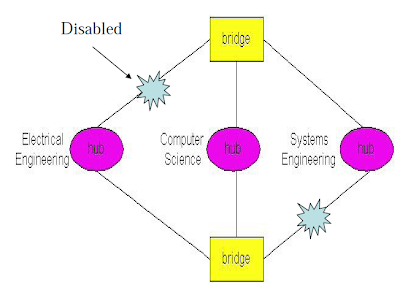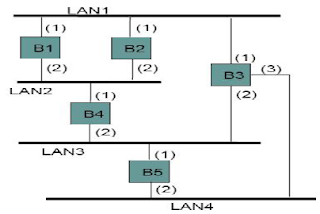• for increased reliability,
desirable to have redundant, alternate paths from source to dest
• with multiple simultaneous
paths, cycles result - bridges may multiply and forward frame forever
• solution: organize bridges in a spanning tree by
disabling subset of interfaces
• As the system grows a complex
graph of many networks and many bridges
appear.
• Frames may loop through
networks!
• Bridges communicate to build
dynamic spanning tree graph, showing the
topology of the network.
• Spanning tree graphs avoid
loops.
• First the bridge with the
smallest serial number becomes the root of the tree.
• Next the tree is constructed.
LAN’s are placed on the nodes, and bridges are
placed on the vertices.
• If a LAN or bridge is no longer
present the tree is updated.
• All networks are on the tree
but to prevent loops some of the bridges are left off
the graph. This makes the graph a
tree
• Elect a single bridge among all
bridges as the root bridge. The algorithm will
select the root bridge as the one
with the lowest bridge id.
• Each bridge (except root)
determines the least cost path (shortest path with respect
to some metric, say hops) from
itself to the root bridge through each of its ports.
The port with least cost is the
root port for that bridge. In case of ties use the
smallest port id.
• Elect a designated bridge for
each LAN from the bridges directly connecting to
that LAN. The designated bride is the one closest to
the root bridge. In case of
ties it is the one with the
lowest bridge id. The port that connects the designated
bridge and the LAN is the
designated port for that LAN.
• Ports in the spanning tree are
all root ports and designated ports. Other ports are
in the blocking state.
• Data traffic is forwarded to
and received from ports in the spanning tree only.
Example
Sample topology
using spanning tree








0 comments